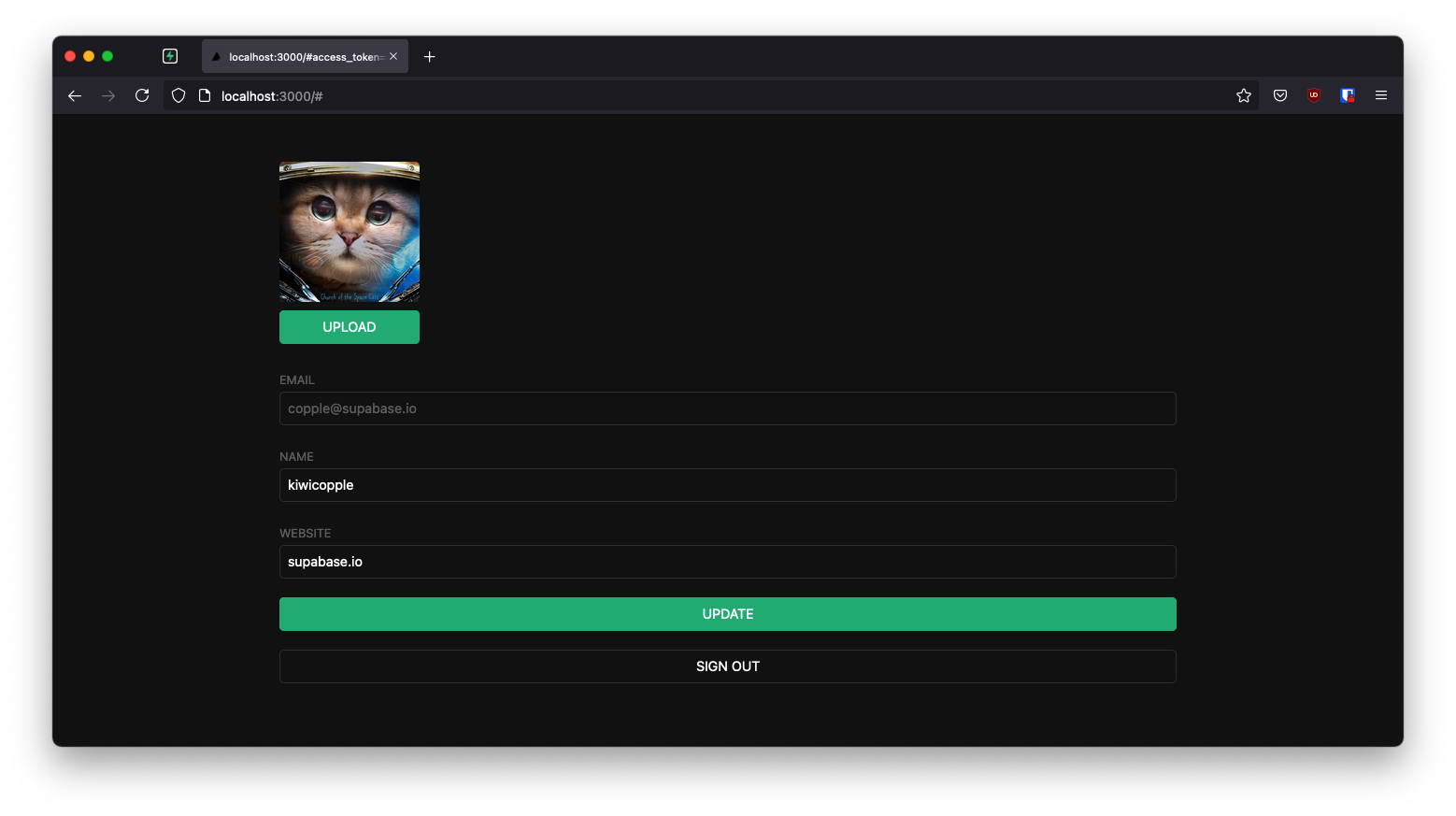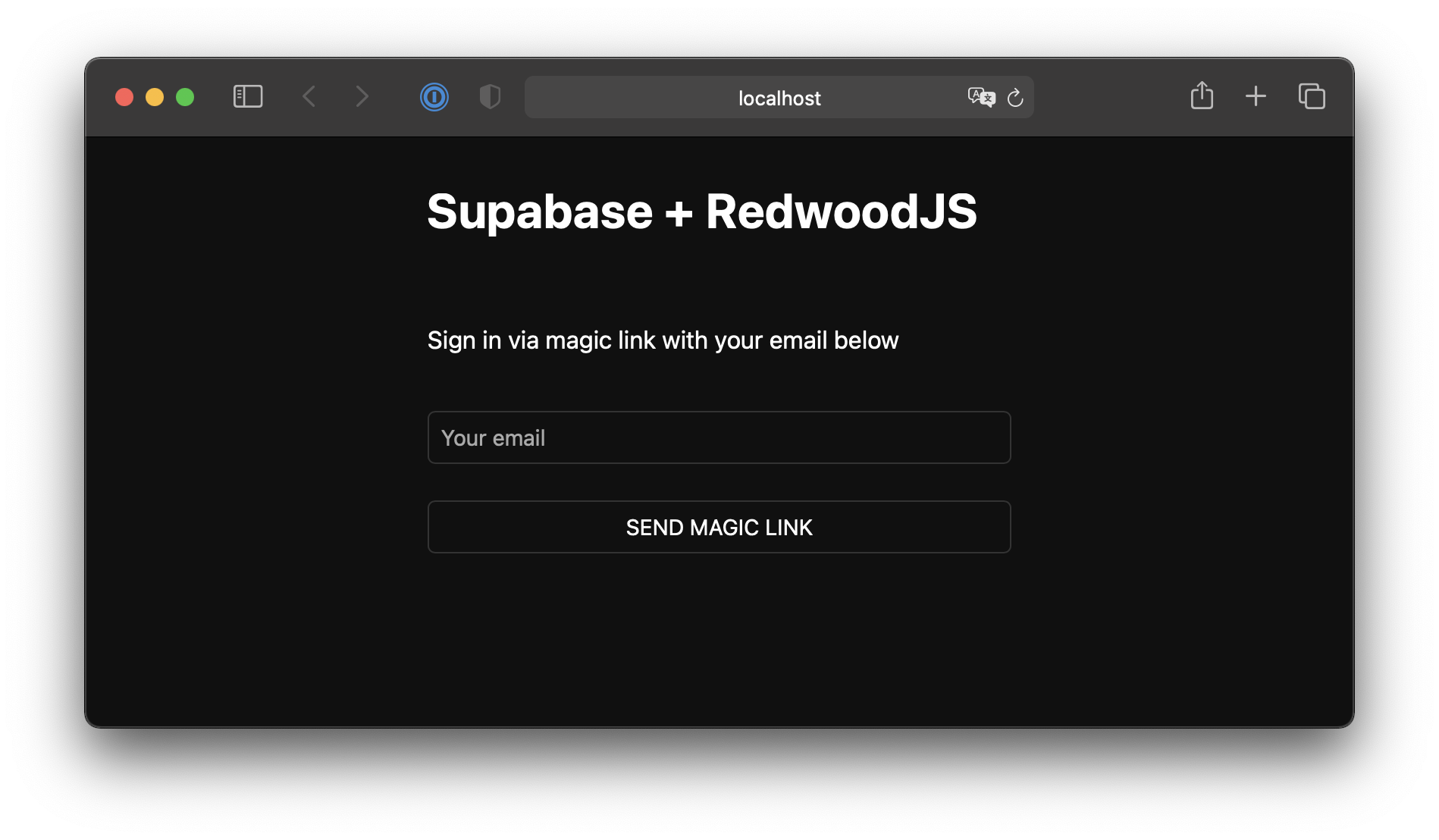快速入门: RedwoodJS
介绍
为了与其他框架的Quickstart例子保持一致,我们将建立一个RedwoodJS,与正常情况下有点不同。
我们不使用Prisma连接到Supabase Postgres数据库或Prisma迁移,因为在Redwood应用中通常会这样做。 相反,我们将依靠Supabase客户端在网络端做一些工作,并在API端再次使用客户端来做数据获取。
这意味着你要避免运行任何 "yarn rw prisma migrate "命令,还要在部署时仔细检查你的构建命令,以确保Prisma不会重置你的数据库。
note
TLDR; Prisma目前不支持跨模式外键,所以由于你的Supabase public模式是如何引用auth.users的,反省模式失败。
这个例子提供了使用Supabase和RedwoodJS建立一个简单的用户管理应用程序的步骤(从头开始!)。它包括。
- MemFire Cloud Database:一个用于存储用户数据的Postgres数据库。
- MemFire Cloud Auth:用户可以用魔法链接登录(没有密码,只有电子邮件)。
- MemFire Cloud Storage:用户可以上传照片。
- Instant APIs。当你创建你的数据库表时,API将自动生成。
- 行级安全:数据受到保护,个人只能访问自己的数据。
在本指南结束时,你将拥有一个允许用户登录并更新一些基本资料细节的应用程序。

note
注意:对于RedwoodJS应用程序,端口将是8910。
GitHub#
如果你在任何时候被卡住了,请看一下这个 repo。
关于RedwoodJS#
一个Redwood应用程序被分成两部分:一个前端和一个后端。这表现为在一个单一的monorepo中的两个node项目。
前台项目被称为web,后台项目被称为api。
它们是独立的项目,因为 "web端 "的代码最终将在用户的浏览器中运行,而 api端的代码将在某个服务器上运行。
note
重要提示:当本指南提到 API时,指的是Supabase API,当它提到 api端时,指的是RedwoodJS api端。
api端是一个GraphQL API的实现。业务逻辑被组织成 服务,代表他们自己的内部API,可以从外部GraphQL请求和其他内部服务中调用。
网络端 "***是用React构建的。Redwood的路由器可以简单地将URL路径映射到React的 页面组件(并在每个路径上自动分割你的应用代码)。
页面可以包含一个 Layout组件来包装内容。它们还包含 单元格和常规的React组件。
单元允许你声明性地管理一个获取和显示数据的组件的生命周期。
note
为了与其他框架的Quickstart例子保持一致,我们将建立一个RedwoodJS,与正常情况下有点不同。
我们不使用Prisma来连接Supabase Postgres数据库或Prisma迁移,因为在Redwood应用中通常会这样做。
相反,我们将依靠Supabase客户端来完成web方面的一些工作,并在api方面再次使用客户端来进行数据获取。
项目设置
在我们开始构建之前,我们要设置我们的数据库和API。这就像在Supabase中启动一个新项目一样简单 然后在数据库中创建一个 "模式"。
note
在设置Supabase时,你会与你的项目仪表板互动。然而,大多数RedwoodJS的设置步骤将与Redwood CLI互动,以生成路由、页面、组件等。 因此,请确保在你的项目目录中准备好一个终端。
创建一个项目
- 进入MemFire Cloud。
- 点击
新项目。 - 输入你的项目细节。
- 等待新数据库的启动。
设置数据库模式
现在我们要设置数据库模式。我们可以使用SQL编辑器中的 用户管理启动器快速启动。
或者你可以直接复制/粘贴下面的SQL,然后自己运行它。
- 进入仪表版中的SQL编辑器页面。
- 点击 用户管理的模板。
- 点击运行。
关于Prisma和迁移的重要说明
note
因为这个快速入门并没有使用Prisma来管理数据库模式、播种或运行迁移,所以在运行一些典型的Redwood CLI命令时,你***需要格外小心。
获取API密钥#
现在你已经创建了一些数据库表,你已经准备好使用自动生成的API插入数据。
我们只需要从API设置中获得URL以及anon、service_role和JWT_SECRET键。
- 进入仪表板中的API设置页面。
- 在这个页面上找到你的API
URL,anon, 和service_role键。
构建应用程序
让我们开始从头开始构建RedwoodJS应用程序。
note
RedwoodJS需要Node.js(>=14.x <=16.x)和Yarn(>=1.15)。
确保你已经安装了yarn,因为RedwoodJS依靠它来在工作空间中管理它的包,用于其web和api"side"。
初始化一个RedwoodJS应用程序#
我们可以使用Create Redwood App命令来初始化
一个名为supabase-redwoodjs的应用程序。
yarn create redwood-app supabase-redwoodjs cd supabase-redwoodjs
当应用程序正在安装时,你应该看到。
✔ Creating Redwood app ✔ Checking node and yarn compatibility ✔ Creating directory 'supabase-redwoodjs' ✔ Installing packages ✔ Running 'yarn install'... (This could take a while) ✔ Convert TypeScript files to JavaScript ✔ Generating types Thanks for trying out Redwood!
然后让我们通过运行setup auth命令来安装唯一的额外依赖supabase-js:
yarn redwood setup auth supabase
当被提示时。
覆盖现有的/api/src/lib/auth.[jt]s?
说,是,它将在你的应用程序中设置Supabase客户端,并提供用于Supabase验证的钩子。
✔ Generating auth lib... ✔ Successfully wrote file `./api/src/lib/auth.js` ✔ Adding auth config to web... ✔ Adding auth config to GraphQL API... ✔ Adding required web packages... ✔ Installing packages... ✔ One more thing... You will need to add your Supabase URL (SUPABASE_URL), public API KEY, and JWT SECRET (SUPABASE_KEY, and SUPABASE_JWT_SECRET) to your .env file.
接下来,我们要在.env中保存环境变量。
我们需要API URL以及你[早些时候]复制的anon和jwt_secret键(#get-theapi-keys)。
.envSUPABASE_URL=YOUR_SUPABASE_URL SUPABASE_KEY=YOUR_SUPABASE_ANON_KEY SUPABASE_JWT_SECRET=YOUR_SUPABASE_JWT_SECRET
最后,你还需要把***的 网络端环境变量保存到 redwood.toml中。
redwood.toml[web] title = "Supabase Redwood Quickstart" port = 8910 apiProxyPath = "/.redwood/functions" includeEnvironmentVariables = ["SUPABASE_URL", "SUPABASE_KEY"] [api] port = 8911 [browser] open = true
这些变量将暴露在浏览器上,这完全没有问题。 它们允许你的Web应用程序使用你的公共匿名密钥初始化Supabase客户端因为我们在数据库中启用了 行级安全 。
你会看到这些被用来在web/src/App.js中配置你的Supabase客户端。
web/src/App.js1// ... Redwood imports
2import { AuthProvider } from '@redwoodjs/auth'
3import { createClient } from '@supabase/supabase-js'
4
5// ...
6
7const supabase = createClient(process.env.SUPABASE_URL, process.env.SUPABASE_KEY)
8
9const App = () => (
10 <FatalErrorBoundary page={FatalErrorPage}>
11 <RedwoodProvider titleTemplate="%PageTitle | %AppTitle">
12 <AuthProvider client={supabase} type="supabase">
13 <RedwoodApolloProvider>
14 <Routes />
15 </RedwoodApolloProvider>
16 </AuthProvider>
17 </RedwoodProvider>
18 </FatalErrorBoundary>
19)
20
21export default App
还有一个可选的步骤是更新CSS文件web/src/index.css以使应用程序看起来漂亮。
你可以找到这个文件的全部内容这里。
启动RedwoodJS和你的第一个页面#
让我们通过启动应用程序来测试我们此刻的设置。
yarn rw dev
note
注意:你也可以用rw来表示redwood,如yarn rw来运行Redwood CLI命令。
你应该看到一个 欢迎来到RedwoodJS的页面和一个关于还没有任何页面的信息。
因此,让我们创建一个 主页。
yarn rw generate page home / ✔ Generating page files... ✔ Successfully wrote file `./web/src/pages/HomePage/HomePage.stories.js` ✔ Successfully wrote file `./web/src/pages/HomePage/HomePage.test.js` ✔ Successfully wrote file `./web/src/pages/HomePage/HomePage.js` ✔ Updating routes file... ✔ Generating types ...
note
注意:这里的斜线/很重要,因为它创建了一个根级路由。
如果你想的话,你可以停止dev服务器;要看到你的改变,只要确保再次运行yarn rw dev。
你应该在web/src/Routes.js中看到Home页面路由。
web/src/Routes.jsimport { Router, Route } from '@redwoodjs/router' const Routes = () => { return ( <Router> <Route path="/" page={HomePage} name="home" /> <Route notfound page={NotFoundPage} /> </Router> ) } export default Routes
设置一个登录组件
让我们建立一个Redwood组件来管理登录和注册。我们将使用Magic Links,所以用户可以用他们的电子邮件登录,而不需要使用密码。
yarn rw g component auth ✔ Generating component files... ✔ Successfully wrote file `./web/src/components/Auth/Auth.test.js` ✔ Successfully wrote file `./web/src/components/Auth/Auth.stories.js` ✔ Successfully wrote file `./web/src/components/Auth/Auth.js`
现在,更新Auth.js组件,包含。
/web/src/components/Auth/Auth.js1import { useState } from 'react'
2import { useAuth } from '@redwoodjs/auth'
3
4const Auth = () => {
5 const { logIn } = useAuth()
6 const [loading, setLoading] = useState(false)
7 const [email, setEmail] = useState('')
8
9 const handleLogin = async (email) => {
10 try {
11 setLoading(true)
12 const { error } = await logIn({ email })
13 if (error) throw error
14 alert('Check your email for the login link!')
15 } catch (error) {
16 alert(error.error_description || error.message)
17 } finally {
18 setLoading(false)
19 }
20 }
21
22 return (
23 <div className="row flex-center flex">
24 <div className="col-6 form-widget">
25 <h1 className="header">Supabase + RedwoodJS</h1>
26 <p className="description">Sign in via magic link with your email below</p>
27 <div>
28 <input
29 className="inputField"
30 type="email"
31 placeholder="Your email"
32 value={email}
33 onChange={(e) => setEmail(e.target.value)}
34 />
35 </div>
36 <div>
37 <button
38 onClick={(e) => {
39 e.preventDefault()
40 handleLogin(email)
41 }}
42 className={'button block'}
43 disabled={loading}
44 >
45 {loading ? <span>Loading</span> : <span>Send magic link</span>}
46 </button>
47 </div>
48 </div>
49 </div>
50 )
51}
52
53export default Auth
设置一个账户组件
在用户登录后,我们可以让他们编辑他们的个人资料细节和管理他们的账户。
让我们为其创建一个新的组件,名为Account.js。
yarn rw g component account ✔ Generating component files... ✔ Successfully wrote file `./web/src/components/Account/Account.test.js` ✔ Successfully wrote file `./web/src/components/Account/Account.stories.js` ✔ Successfully wrote file `./web/src/components/Account/Account.js`
然后更新文件,使其包含:
web/src/components/Account/Account.js1import { useState, useEffect } from 'react'
2import { useAuth } from '@redwoodjs/auth'
3
4const Account = () => {
5 const { client: supabase, currentUser, logOut } = useAuth()
6 const [loading, setLoading] = useState(true)
7 const [username, setUsername] = useState(null)
8 const [website, setWebsite] = useState(null)
9 const [avatar_url, setAvatarUrl] = useState(null)
10
11 useEffect(() => {
12 getProfile()
13 }, [supabase.auth.session])
14
15 async function getProfile() {
16 try {
17 setLoading(true)
18 const user = supabase.auth.user()
19
20 let { data, error, status } = await supabase
21 .from('profiles')
22 .select(`username, website, avatar_url`)
23 .eq('id', user.id)
24 .single()
25
26 if (error && status !== 406) {
27 throw error
28 }
29
30 if (data) {
31 setUsername(data.username)
32 setWebsite(data.website)
33 setAvatarUrl(data.avatar_url)
34 }
35 } catch (error) {
36 alert(error.message)
37 } finally {
38 setLoading(false)
39 }
40 }
41
42 async function updateProfile({ username, website, avatar_url }) {
43 try {
44 setLoading(true)
45 const user = supabase.auth.user()
46
47 const updates = {
48 id: user.id,
49 username,
50 website,
51 avatar_url,
52 updated_at: new Date(),
53 }
54
55 let { error } = await supabase.from('profiles').upsert(updates, {
56 returning: 'minimal', // Don't return the value after inserting
57 })
58
59 if (error) {
60 throw error
61 }
62
63 alert('Updated profile!')
64 } catch (error) {
65 alert(error.message)
66 } finally {
67 setLoading(false)
68 }
69 }
70
71 return (
72 <div className="row flex-center flex">
73 <div className="col-6 form-widget">
74 <h1 className="header">Supabase + RedwoodJS</h1>
75 <p className="description">Your profile</p>
76 <div className="form-widget">
77 <div>
78 <label htmlFor="email">Email</label>
79 <input id="email" type="text" value={currentUser.email} disabled />
80 </div>
81 <div>
82 <label htmlFor="username">Name</label>
83 <input
84 id="username"
85 type="text"
86 value={username || ''}
87 onChange={(e) => setUsername(e.target.value)}
88 />
89 </div>
90 <div>
91 <label htmlFor="website">Website</label>
92 <input
93 id="website"
94 type="website"
95 value={website || ''}
96 onChange={(e) => setWebsite(e.target.value)}
97 />
98 </div>
99
100 <div>
101 <button
102 className="button primary block"
103 onClick={() => updateProfile({ username, website, avatar_url })}
104 disabled={loading}
105 >
106 {loading ? 'Loading ...' : 'Update'}
107 </button>
108 </div>
109
110 <div>
111 <button className="button block" onClick={() => logOut()}>
112 Sign Out
113 </button>
114 </div>
115 </div>
116 </div>
117 </div>
118 )
119}
120
121export default Account
note
注意:你会在快速入门中多次看到useAuth()的使用。Redwood的useAuth钩子提供了方便的方法来访问
logIn, logOut, currentUser,以及访问supabase验证客户端。我们将使用它来获得一个
的实例来与你的API交互。
更新主页
现在我们已经有了所有的组件,让我们更新你的HomePage页面来使用它们。
web/src/pages/HomePage/HomePage.js1import { useAuth } from '@redwoodjs/auth'
2import { MetaTags } from '@redwoodjs/web'
3
4import Account from 'src/components/Account'
5import Auth from 'src/components/Auth'
6
7const HomePage = () => {
8 const { isAuthenticated } = useAuth()
9
10 return (
11 <>
12 <MetaTags title="Welcome" />
13 {!isAuthenticated ? <Auth /> : <Account />}
14 </>
15 )
16}
17
18export default HomePage
我们在这里做的是,如果你没有登录,就显示登录表,如果你登录了,就显示你的账户资料。
启动
一旦完成,在终端窗口运行这个程序,启动dev服务器。
yarn rw dev
然后打开浏览器到localhost:8910,你应该看到完成的应用程序。

个人照片
每个Supabase项目都配置了存储,用于管理照片和视频等大文件。
创建一个上传小组件
让我们为用户创建一个头像,以便他们可以上传个人资料照片。我们可以从创建一个新的组件开始。
yarn rw g component avatar ✔ Generating component files... ✔ Successfully wrote file `./web/src/components/Avatar/Avatar.test.js` ✔ Successfully wrote file `./web/src/components/Avatar/Avatar.stories.js` ✔ Successfully wrote file `./web/src/components/Avatar/Avatar.js`
现在,更新你的 "头像 "组件,使其包含以下小部件。
web/src/components/Avatar/Avatar.js1import { useEffect, useState } from 'react'
2import { useAuth } from '@redwoodjs/auth'
3
4const Avatar = ({ url, size, onUpload }) => {
5 const { client: supabase } = useAuth()
6
7 const [avatarUrl, setAvatarUrl] = useState(null)
8 const [uploading, setUploading] = useState(false)
9
10 useEffect(() => {
11 if (url) downloadImage(url)
12 }, [url])
13
14 async function downloadImage(path) {
15 try {
16 const { data, error } = await supabase.storage.from('avatars').download(path)
17 if (error) {
18 throw error
19 }
20 const url = URL.createObjectURL(data)
21 setAvatarUrl(url)
22 } catch (error) {
23 console.log('Error downloading image: ', error.message)
24 }
25 }
26
27 async function uploadAvatar(event) {
28 try {
29 setUploading(true)
30
31 if (!event.target.files || event.target.files.length === 0) {
32 throw new Error('You must select an image to upload.')
33 }
34
35 const file = event.target.files[0]
36 const fileExt = file.name.split('.').pop()
37 const fileName = `${Math.random()}.${fileExt}`
38 const filePath = `${fileName}`
39
40 let { error: uploadError } = await supabase.storage.from('avatars').upload(filePath, file)
41
42 if (uploadError) {
43 throw uploadError
44 }
45
46 onUpload(filePath)
47 } catch (error) {
48 alert(error.message)
49 } finally {
50 setUploading(false)
51 }
52 }
53
54 return (
55 <div>
56 {avatarUrl ? (
57 <img
58 src={avatarUrl}
59 alt="Avatar"
60 className="avatar image"
61 style={{ height: size, width: size }}
62 />
63 ) : (
64 <div className="avatar no-image" style={{ height: size, width: size }} />
65 )}
66 <div style={{ width: size }}>
67 <label className="button primary block" htmlFor="single">
68 {uploading ? 'Uploading ...' : 'Upload'}
69 </label>
70 <input
71 style={{
72 visibility: 'hidden',
73 position: 'absolute',
74 }}
75 type="file"
76 id="single"
77 accept="image/*"
78 onChange={uploadAvatar}
79 disabled={uploading}
80 />
81 </div>
82 </div>
83 )
84}
85
86export default Avatar
添加新的小组件
然后我们就可以把这个小部件添加到账户组件中。
web/src/components/Account/Account.js1// Import the new component 2import Avatar from 'src/components/Avatar' 3 4// ... 5 6return ( 7 <div className="form-widget"> 8 {/* Add to the body */} 9 <Avatar 10 url={avatar_url} 11 size={150} 12 onUpload={(url) => { 13 setAvatarUrl(url) 14 updateProfile({ username, website, avatar_url: url }) 15 }} 16 /> 17 {/* ... */} 18 </div> 19)
下一步
在这个阶段,你已经有了一个功能完备的应用程序!
- 有问题吗?在此提问.
- 请登录MemFire Cloud
- 了解更多关于RedwoodJS
- 访问RedwoodJS论述社区